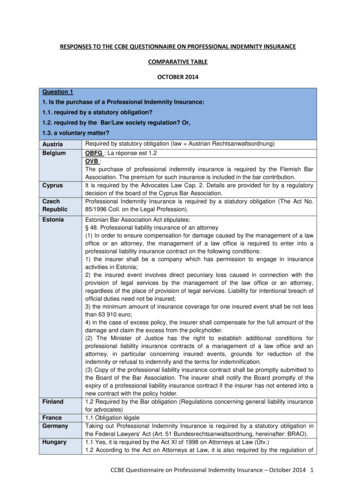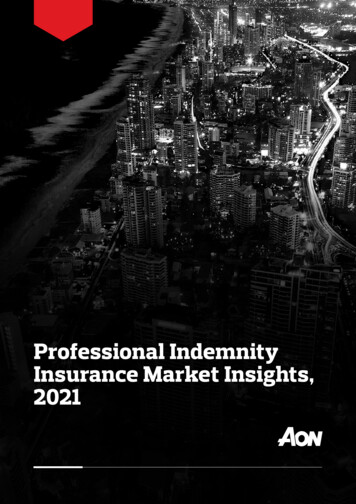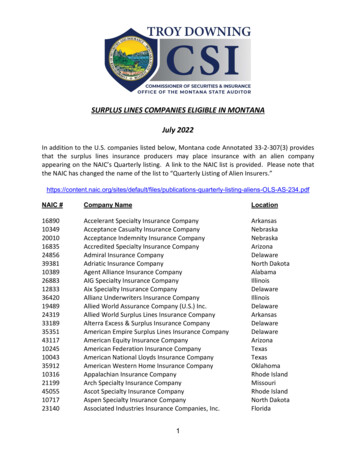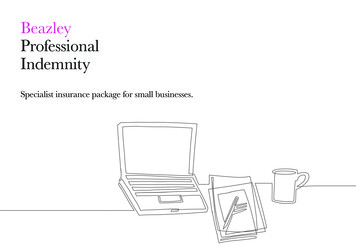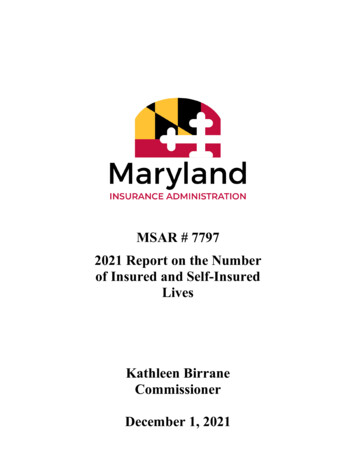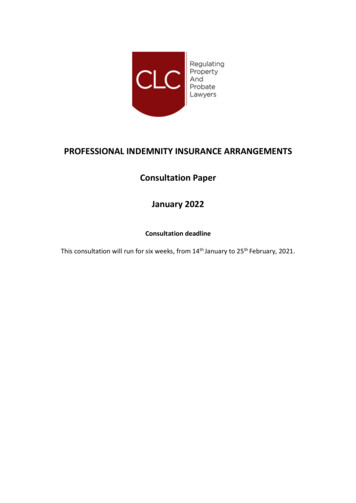
Transcription
PROFESSIONAL INDEMNITY INSURANCE ARRANGEMENTSConsultation PaperJanuary 2022Consultation deadlineThis consultation will run for six weeks, from 14th January to 25th February, 2021.
PROFESSIONAL INDEMNITY INSURANCE ARRANGEMENTSBackgroundAll entities regulated by the CLC are required to have Professional Indemnity Insurance (PII)to protect their clients. With CLC-regulated entities entrusted with conveyancing andprobate transactions that involve people’s largest assets and life savings, PII is a vitalelement of consumer protection and the overall regulatory arrangements put in place bythe CLC.The CLC last reviewed its PII scheme in 2016. Following that root and branch review andconsultation with the regulated community, insurers, and other stakeholders, the CLCmoved to an open market PII scheme based on standard Minimum Terms and Conditions(MTC) and governed by a Participating Insurers Agreement (PIA). That PII cover must meetthe CLC’s MTC (and it may provide greater cover if the regulated entity believes that isappropriate) and it must be provided by one or more of the insurers that are party to thePIA. Those insurers must be rated at least ‘A’.The operation of a PII scheme engages the following Regulatory Objectives set out by theLegal Services Act 2007:RO1: Protecting and promoting the public interest – by a more responsive andsuitable range of PII outcomes for the profession, and indirectly, their clients.RO4 - protect and promote the interests of consumers – by ensuring that effectivePII is in place;RO5 - promote competition in the provision of legal services – by ensuring thatcompetitively priced PII is available and access to the market is notdisproportionately inhibited; andRO6 - encourage an independent, strong, diverse and effective legal profession –through affordable PII provision.The CLC’s PII offers protection to clients of regulated entities, including mortgage lenders tothose clients. It covers the regulated entity for civil liability incurred arising out of regulatedservices provided. It relates only to third party loss and not to losses incurred by theregulated entity. Therefore, regulated entities should also consider whether they need tohave in place other insurance to protect itself and its officers such as separate cyberinsurance to meet the cost of restoration of systems and date in the event of a cyberincidence and insurance to indemnify directors and officers against other claims arising fromalleged wrongdoing in the course of their duties.1In two separate working sessions over the past six months, the Council of the CLC hasconsidered the issues and options raised through the review process and prepared the wayfor this formal consultation.For further information on cyber insurance please refer es-to-the-clcs-minimum-terms-and-conditions/12
This consultationThe passage of time since the current scheme was launched and the pressure of a hardmarket for PII prompted the CLC to issue a call for evidence about the operation of thescheme and the market in June 2021 as the first stage of a comprehensive review. The nextstage was a series of conversations with insurers and brokers as well as discussions in openforums for the regulated community.The CLC’s open market scheme has worked well, enabling a choice of provider and generallylower cost insurance for the CLC’s regulated community. Therefore this consultation isfocused on those issues that have emerged over the course of the review as requiringconsideration at this stage to address the current challenges in the PII market. It is alsorelevant that work by the LSB that is just beginning on the operation of PII across the legalsector might inform a further review in the coming years.This consultation therefore sets out the CLC’s proposals for limited changes to its PII schemethat seem appropriate to ensure that: it continues to operate effectively to protect the interests of clients; PII is affordable and proportionate for conveyancing and probate services thatdeliver the safe handling of the major personal assets of clients; it supports a healthy and competitive PII market; and it supports innovation and growth in the legal services market.The proposals include potential amendments to the MTC and PIA. The current wording ofthose can be found at Appendices A and B respectively. We do not envisage any changesto the CLC Professional Indemnity Insurance Framework or CLC Professional IndemnityInsurance Code and GuidanceWhy this consultation is important to youPractices regulated by the CLC and their representative bodies should consider how theoptions set out in this consultation could affect the protection of their clients, their businessand themselves. The availability and pricing of effective PII cover is vital to the viability oflegal service provision. NB If your practice has concerns about the next PII insurancerenewal, speak to your broker early and consult the CLC’s most recent Risk Agenda for ients of regulated entities and organisations representing consumers should considerwhether the options set out in this consultation have any negative or positive impact onclient protection.Mortgage lenders and financial institutions working with probate providers shouldconsider whether the options set out in this consultation have any impact on the protectionof their clients and themselves.Other organisations in the property and probate sectors should consider whether theoptions set out in this consultation have any impact on the protection of their clients andthemselves.3
Responding to this consultationYou can respond to the consultation by email to consultations@clc-uk.org or by post to: TheCouncil for licensed Conveyancers, WeWork, 131 Finsbury Pavement, London, EC2A 1NT.The CLC will publish all responses and may refer to any of them specifically in any furtherdocument it publishes following this consultation. If you wish your response to be treated asconfidential, please let us know when you respond.In addition to promoting this consultation paper, the CLC intends to hold furtherdiscussions with regulated entities, PII brokers and insurers, representative bodies for theregulated community. We will also circulate a brief questionnaire to gauge opinion on thekey issues.Consultation deadlineThis consultation will run for six weeks, from 14th January to 25th February, 2021.Next stepsThe Council for the CLC will agree any changes to the PII scheme at is meeting on 10th Marchfor submission to the LSB for approval ahead in good time for the 2021 PII renewal period inJune.4
IntroductionAt a workshop meeting in September 2021, the Council of the CLC discussed the broadlines for a review of the CLC’s arrangements for Professional Indemnity Insurance (PII). Thediscussion was based on submissions to the call for evidence that ran from June toSeptember 2021, and the CLC’s own thinking on potential changes and ideas that had beenpassed to the CLC informally at private or public meetings.Following that workshop, there were further discussions with the current brokers andinsurers to the CLC’s scheme within the parameters set by Council. In November 2021, theCouncil reviewed the key issues and options that had emerged from the review processsince the beginning of the call for evidence in June. The Council agreed that the CLC shouldconsult on possible amendments to the PII scheme in the following areas:1.2.3.4.5.6.Breadth of cover provided by the MTC.Temporary extension of cover in the event of sudden practice closure.Ensuring that closing practices have run-off cover in place.The approach to excesses set by insurers.The need for a Participating Insurers Agreement.Whether stand-alone cyber insurance should be mandatory.The CLC is also proposing some amendments to MTC to reflect provisions of the 2016Insurance Act. This is covered at 7, below.In addition, the Council agreed some changes to working practices aimed at improvingsupport for transferring practices and start-ups as they seek to secure PII. These do notrequire any amendments to the MTC or PIA.Breadth of cover provided by the MTCBreadth of general cover – narrowing cover by transaction typeAnother option which can be disposed of is the potential of narrowing cover to only verystraightforward residential conveyancing transactions, as has been suggested during thereview. Insurers have agreed that this is problematic and the CLC’s view is that it wouldexpose clients to risk arising from disputes about whether a particular transaction qualifiedfor cover. It would also increase the exposure of the Compensation Fund, effectivelytransferring risk from the individual practice to the entire regulated community.Alongside an unfair regulatory burden, this would also pose operational issues. Forexample, investigations under the Compensation Fund can be expensive. This couldlead to a rise in costs later. Reliance on this model may also result in reputationaland other impacts for the profession and clients under some scenarios, as theCompensation Fund does not have the same purpose as PII and is a discretionaryfund.Breadth of general cover – narrowing cover by client typeIt has been suggested that lenders that experience a loss at the hands of a CLC-regulatedentity could be excluded from recourse to compensation through PII. This is likely to5
concern lenders considerably and it could damage significantly CLC-regulated firms’ place inthe market, but it is a point on which we have little evidence base of lender-based claims.There has also been a suggestion that clients that are a business rather than an individualshould also be ineligible to make a claim on the basis that they should not need theprotection that a private individual needs. The CLC’s view is that small businesses are inmost respects like an individual in their vulnerability to the impact of errors made bylawyers. Indeed, according to the LSB small firms may need more protection. They havestated that there are high rates of problems they face, which can be greater than for someindividuals. 2If businesses were to be excluded, a distinction would need to be made between smallbusinesses and those that are sophisticated and sufficiently resourced to protect their owninterests when engaging a lawyer. This would seem to indicate that only those businesseswith an in-house legal function could be excluded from eligibility to make a claim. Given theprofile of the work undertaken by CLC-regulated practices is overwhelmingly residential, thiswould have little positive impact on the availability or affordability of PII.The CLC does not propose to make any changes to the breadth of cover provided by theMTC.Extension of cover in the event of sudden closureThe current MTC do not include provision for a short extension of full indemnity cover in theevent that a practice is unable to renew PII cover at the end of an insurance year. A shortextension would allow the practice to complete matters or arrange for their transfer toother practices for completion under full PII. It is not intended as an extension to thedeadline for securing ongoing PII. Insurers have generally agreed to such extensions on acase-by-case basis, and it will be useful to systematise the approach.The practice would not be able to take on any new instructions during the extended periodof cover and that cover would be provided at no additional cost.Draft amended MTC for this approach1.18 Period of InsurancePeriod of Insurance means the period specified as such in the Evidence of Insurance and shall,where the context requires, include any Extended Period of Insurance as provided for in clause1.18A below.1.18A This Insurance will provide cover in accordance with the Insuring Clauses (but subject tothe limits, exclusions and conditions of this Policy) for the period specified in clause 1.18Bbelow (“the Extended Period of Insurance”) if the Insured Practice has not, prior to theexpiration of the Period of Insurance, either renewed this Insurance or obtained insurance thatprovides cover that is equivalent to and on terms no less favourable than this Insurance andthat incepts on the day immediately following the expiration of the Period of es-2013-20206
1.18B The Extended Period of Insurance referred to in clause 1.18A above is the periodcommencing at the end of the Period of Insurance and ending on the earliest of:1.18B.1 the date of inception of any insurance obtained by the Insured Practicethat provides cover that is equivalent to and on terms no less favourablethan this Insurance;1.18B.2the day on which the Insured Practice ceases; or1.18B.3the day which is 60 days after the end of the Period of InsuranceCONSULTATION QUESTION 1Do you have any comments on the proposed automatic 60-day extension of PII cover in theevent that a practice is unable to renew cover at the end of the insurance year?Ensuring that closing practices have run-off cover in placeThe CLC’s PII scheme is on a ‘claims made’ basis, meaning that the insurance purchased for aparticular year covers claims made during that year regardless of when the incident givingrise to the claim occurred. For that reason, practices regulated by the CLC that cease toprovide regulated legal services are required to have PII in place for six years followingclosure to ensure that claims in respect of past work are covered. This is called ‘run-off’cover.Section 5 of the Professional Indemnity Insurance Code states:You ensure there are adequate indemnity arrangements in respect of claims made againstyou for work carried out by you before you ceased to practice by taking out professionalindemnity insurance for a minimum period of 6 years from the expiry of the periodof professional indemnity insurance stated in your evidence of insurance or policydocument.After the six-year period of run-off cover, clients with a claim may apply to theCompensation Fund managed by the CLC and funded by the regulated community. Very fewclaims are made to the Compensation Fund in relation to practices that ceased operatingmore than six years prior to the claim.The very small number of relevant claims on the Compensation Fund indicates that the sixyear period suffices to meet the vast majority of claims for the past work of closed practices.Likewise, there is no suggestion that the current run-off cover limit of 2m in aggregate forall claims is insufficient. Therefore the CLC sees no need to consider any changes to thenature and extent of run-off cover at this stage.Before 2016, some closed firms did not purchase run-off cover, leaving consumers exposedto potential losses and adding to the potential burden on the Compensation Fund. Underthe current scheme, run-off cover is integrated into annual PII. The insurer of a practice atthe time that practice closes is required to provide run-off cover for six years at no further7
cost to the practice. Some insurers have said that this makes it difficult for them to providecompetitively priced cover and it seems that the risk to the insurer of the potential need toprovide run-off cover has not been priced into annual premiums by those insurers. This hascontributed to the challenge of the insurance market as it seeks to improve sustainabilityand profitability.The CLC regards integrated run-off cover as a key aspect of consumer protection as itguarantees that there is provision for claims against closed practices. However, during theperiod of this review, four possible amendments to the current run-off provisions emerged: Reducing the extent of cover Requiring payment of an additional premium for run-off cover other than inlimited circumstances Allowing insurers to seek payment of an additional premium for run-off coverwithout making payment a condition of cover Potential run-off premium being held by practices/a CLC scheme to meet costs ofrun-off premiumsWe will now look at each of these in turn.Reducing the extent of coverOne organisation consulted by the CLC noted that the limit of run-off cover of 2m for allclaims in the six-year period could be reduced significantly because claims in respect ofclosed practices almost always amount to far less than 2m. The suggestion is thatconsumer protection could be secured by a lower limit.However, it has also been pointed out that insurers’ approach to run-off takes account ofthe actual exposure they face being in effect far lower than 2m and so a reduction in thelimit would not have an impact on insurer participation in the market, nor reducepremiums. A reduction in cover would increase the exposure of the Compensation Fund,and so increase the burden on the regulated community. Therefore, the CLC sees no casefor further consideration of this idea.For similar reasons, there is no need to move away from an aggregate limit of 2m for allclaims in the run-off period to a basis which would set a limit for each and every claimmade.Requiring payment of an additional premium for run-off cover in all but limitedcircumstancesLimiting the availability of run-off cover free at the point of closure depending on thecircumstances of that closure could be a way to meet the concerns of some insurers aboutintegrated run-off cover but it opens risks to consumer protection.In this approach, run-off would be provided without additional payment by insurers in theevent of an intervention by the CLC or other unplanned closure of a practice. Wherepractices are winding up in an orderly fashion it is reasonable to expect those business tomake provision for run-off cover. In the case of a practice moving out of regulation by theCLC but that is continuing to operate under other regulation, the CLC would hope that the8
insurer would provide unbroken cover with no need to cover past work through run-off.(That is the CLC’s expectation in the case of practices transferring into CLC regulation.)The provision of run-off without payment of an additional premium would be limited to thefollowing causes of practice closure:a. An intervention into the practice by the CLC;b. Death, long-term severe illness or incapacitation of a principal leading toclosure of the practice;c. Because the practice is unable to renew PII; ord. Insolvency of the practice.In all other circumstances an additional premium payment for run-off cover would berequired. When a practice is closing, it would be free to source run-off cover from anyinsurer that is signed up to the PIA.However, this approach would open the possibility of a closed practice not purchasing runoff cover. This would require the CLC to pursue the practice to enforce payment wherepossible. This would cause an unjustifiable reduction in client protection and expose theCompensation Fund to greater risk. Therefore it is not an approach the CLC intends topursue.Allowing insurers to seek payment of an additional premium for run-off cover withoutmaking payment a condition of coverThe Council of the CLC has ruled out moving away from integrated run-off cover entirely onthe basis that it would open clients and the Compensation Fund to considerable risk.However, an alternative approach would require run-off to be funded by an additionalpremium but to prohibit insurers from making the payment of the run-off premium acondition of cover. It would be the responsibility of the insurer to enforce payment of thepremium, but non-payment of that premium could not result in withdrawal of run-off cover.This approach would ensure that all closed practices have run-off cover but allow insurers tosecure a premium for that cover wherever possible. It would naturally ensure that practicesthat close because of intervention, death or insolvency had run-off cover in place, because itwould be automatic.Some insurers have indicated support for such an approach. It could encourage moreinsurers to enter the market by reducing insurers’ risk of exposure without additionalpremiums in the event of practice closure. It would not appear to impact clientprotection that is currently secured through integrated run-off cover. However, the CLCwould need to be convinced by insurers that it is an approach that they would accept forthe long term.Draft amended MTC for this approach8.11 Scope of run-off coverThis Insurance will provide run-off cover in the circumstances set out in General Conditions8.10 above and in accordance with the Insuring Clauses (but subject to the limits,9
exclusions and conditions of this Policy) on the basis that the Period of Insuranceextends for an additional six years (ending on the sixth anniversary of the date uponwhich, but for this requirement it would have ended).8.11 A The provision of run-off cover may result in an additional premium being payable, butit is not a condition precedent of run-off cover being provided that such premium is paid.Run-off cover – premium held in escrow/CLC runs scheme to cover annual run-off costsTwo further alternative arrangements have been floated in recent years.The first is requiring firms to always hold a sum equivalent to the likely cost of run-off. This isrejected because of the disproportionate burden it would represent to practices.The second is the suggestion that the CLC could manage a scheme that collects money fromacross the regulated community to create a fund to pay run-premiums where they are needed.Such funds could perhaps be collected annually from practices rather like contributions to theCompensation Fund. This is rejected because it would represent an unfair burden on themajority of practices as they would be funding the needs of a very small minority.CONSULTATION QUESTION 2a. If the MTC were to be amended to require the last insurer of a practice to provide runoff cover even if it is unable to collect the expected premium, compared to retainingintegrated run-off cover would this have any positive or negative impact on:i. client protection?ii. the availability of choice of PII cover for CLC-regulatedpractices?iii. the price of PII cover?b. Insurers are asked to confirm that they would always provide run-off insurance when apractice has not paid a run-off premium.c.Practices are asked to comment on how they would propose to fund the purchase ofrun-off cover in the event of closure given that retaining a large sum in reserve for thateventuality would be likely to be unviable.The need for a Participating Insurers Agreement (PIA)The CLC operates a Participating Insurers Agreement, which all insurers to the scheme mustsign up to. It sets out standards that insurers must meet in the provision of PII beyondadherence to the MTC, including reporting to the CLC, and the requirements for run-offcover. As such, it is a cornerstone of the protections afforded by the PII scheme.It was suggested by a member of the regulated community that abandoning the PIA couldmake it easier for new insurers to enter the market. However, at time of writing, noobjection has been lodged to the PIA and no insurers have indicated that it inhibits market10
entry or competition in the market. If the PIA were not used as a way of managing thescheme, elements of it would need to be reproduced in the CLC’s PII Code or in the MTCs asa way of securing the outcomes the PIA currently secures. Accordingly, the CLC’s view is thatthe PIA should be retained.CONSULTATION QUESTION 3Do you consider that there is any reason to move away from the PIA that would outweighthe potential impact on consumer protection? Could the same standards of PII be secured ina different way?The role of excessesUnder the current scheme, the CLC sets a maximum level of excess payments by insuredpractices based on the turnover of those practices. That is intended to protect the financialstability of those practices. At time of writing, the preference of some insurers is to be freeto set excesses at any level they choose. They say that this enables them to deliveraffordable premiums and to direct insured practices away from higher-risk types of work.While this may seem a reasonable tool if used within reasonable bounds, we have seenattempts by some insurers to set very high levels of excess in relation to particular types ofwork which, if they were applied to even a small number of claims, could make the insuredpractice insolvent. This seems to the CLC to present a risk to clients, though insurers wouldargue that it motivates the insured practice to avoid the targeted types of work and sodecreases risk.The CLC proposes that it should continue to set maximum excess levels based on practiceturnover but allow insurers to depart from those levels where the insurer can justify ahigher excess level to the CLC. This approach could allow the CLC to deepen its insight intothe use of excesses and their role in the market. The CLC does not propose extending thisapproach to penalty excesses at this stage as there has been no evidence so far that thesepresent a problem.Draft amended MTC for this approach1.12 ExcessExcess means the applicable amounts stated in the Evidence of Insurance for which theInsured is responsible under this Policy in respect of any one Loss or Claim against theInsured. The Excess shall not apply to Defence Costs. The Excess does not reduce the limitof liability of the Insurers.1.12 A Subject to clause 1.12B below, the Excess shall be in an amount not exceeding 3,500 or the sum produced by the following formula if that is greater:(i) 5% Fees (as defined in the CLC’s PII Policy Wording) where the Fees are nomore than 200,000; plus(ii) 3% Fees on Fees between 200,001 and 500,000; plus(iii) 2% Fees on Fees between 500,001 and 1,000,000.11
1.12B The Excess may be in an amount exceeding the sum produced by the formula set out in clause1.12A above if (and only if) the CLC provides written approval of such higher amount.Corresponding Amendment to PIA2.10 If the Insurer wishes to set an Excess (as defined in the CLC PII Policy Wording) thatis in an amount exceeding the sums produced by the formula set out in clause 1.12A ofthe CLC PII Policy Wording, it shall provide written representations to the CLC to explainwhy it considers such higher excess to be justified. On receipt of any such representationsthe CLC may, in its absolute discretion, provide the Insurer with written approval to setthe Excess in the amount requested by the Insurer, or in such lower amount as the CLCconsiders appropriate. For the avoidance of doubt, the CLC may not require the Insurerto set an Excess that is, in either case, below the amount produced by the formulae setout in clauses 1.12A of the CLC PII Policy Wording.CONSULTATION QUESTION 4Does the retention of the excess limit in all but exceptional cases have any impact onconsumer protection or the availability or cost of PII? What positive or negative impactscould the removal of the excess limits have?Whether stand-alone cyber insurance should be mandatedThe CLC amended the MTC in autumn 2021 to meet the requirement for clarity in relationcyber cover in PII. The intention was to clarify what was already covered in terms of civilliability and what was not in terms of the costs of restoring systems and data.Some PII insurers already require their insureds to take out stand-alone cyber insurance tocover those costs of restoration and others have suggested that the CLC should make thismandatory. For the moment, it may be that this is an issue that the market could resolve.Cyber incidents present a clear risk to clients and the costs of restoring systems and dataquickly and effectively to protect client interest are likely to be very significant in mostcases, potentially representing a threat to an affected practice’s financial viability and thus afurther risk to the client interest.Furthermore, claims under PII in the event of a cyber incident could be very considerable ifthe affected practice is not able to recover any affected systems and data effectively toallow transactions to progress with minimal delay. We believe that it is likely that theseand other evolving forms of cyber risk could become more complex and proliferate.A decision to make cyber cover mandatory would not entail changes to the MTC or PIA atthis stage. We are seeking views on whether the CLC should make such cover mandatoryalongside PII or whether insurers will themselves require it without regulatory intervention.A third approach might be for the CLC to require a practice to have cyber cover unless it canexplain why it is unnecessary.CONSULTATION QUESTION 512
a. Could there be any negative impacts from the CLC making cyber cover compulsoryfor all regulated practices?b. Can the CLC rely on the insurance market and regulated entities working together toaddress the risk of cyber incidents to clients and practices?Insurance Act 2015Based on legal advice, the CLC proposes to amend clause 8.1 (“Innocent Non-Disclosure”) ofthe MTC to ensure it is compliant with the terms of the Insurance Act 2015.Clause 8.1 currently provides, in outline, as follows:(i)Insurers will not avoid the policy for “non-disclosure or misrepresentation of factsor untrue statements in the proposal form” if the Insured proves that it was “freeof any fraudulent intent” (clause 8.1).(ii)If the Insured fails to prove its innocence, then:(a) No indemnity will be provided for claims “arising from or connected with”the non-disclosure etc. (clause 8.1.1).(b)Indemnity will be provided for claims “not arising from or connected with”the non-disclosure etc. (clause 8.1.3).(c)If a claim is paid, despite a fraudulent non-disclosure having been made,then the Insured shall at either the CLC’s or Insurers’ request:a.seek to obtain reimbursement “of the benefit of this Policy” from therelevant Principal “concerned in or making” the fraudulent nondisclosure (clause 8.1.5.1); andb.procure that any money “due to” the Principal in
CLC Professional Indemnity Insurance Framework or CLC Professional Indemnity Insurance Code and Guidance Why this consultation is important to you . . If you wish your response to be treated as confidential, please let us know when you respond. In addition to promoting this consultation paper, the CLC intends to hold further .

